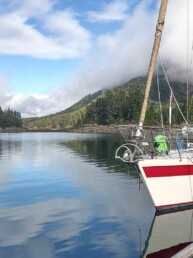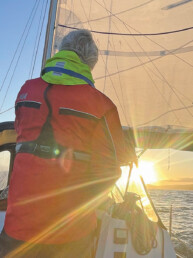This article was originally published in the April 2022 issue of 48° North.
Ten days on a boat? With a baby?” friends asked when they learned about our plan to cruise the San Juan Islands on our 28-foot sailboat. “Are you nuts?”

Being nuts had never occurred to us. We had spent two years dreaming about and working towards this trip. I was operating on blind faith and had no idea what to expect. But Dan’s lifelong boating experience along with his certainty and enthusiasm inspired trust, and I was all in.
Our maiden voyage opened my eyes to certain realities of our venture. Traveling north at a snail’s pace, with wind on our nose rendering sails inefficient, was agonizing. Cabin leaks when it rained and sleepless nights when a sudden change of weather caused our little boat to rock relentlessly gave me pause, to put it mildly. There was no easy way to wash clothes or diapers, never mind our bodies. Childcare fell to me when Dan was getting us from one anchorage to the next. The way I saw it, I was doing the same things I did at home, but in a much smaller space with belongings stowed in hard-to-reach places. I was convinced that summer’s cruise would not only be our first boat trip, but also our last.
Looking back on that moment in time, it would have been hard to imagine that we would spend two decades’ worth of summers, with two daughters and a dog, exploring the coastal waters between Seattle and Prince Rupert. We arranged increasingly longer summer breaks from work, up to 10 weeks one year, and changed boats to accommodate our cruising goals and suit our growing family’s needs. We grew to love not only the coastline and waters of this magnificent cruising paradise, but also the connection and closeness we felt as a family during these trips.
Entertainment
Many have written knowledgeably on these pages about ways they keep their children engaged and safe, whether cruising for a week or a year or more. The trick for me during the early cruising years was learning that our kids could easily be entertained on the boat and, in fact, were content beyond anything I’d witnessed at home. True and special as that was, it certainly required patience, ingenuity, and determination on our part.
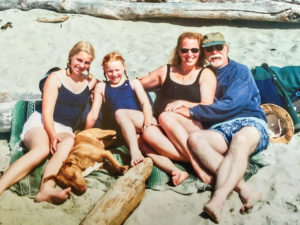
Instead of cartoons in the morning (no television on board!), we sat in the cockpit watching the sunlight twinkling on the water or the mist rising over the mountains. Seals popping their heads up and curiously observing us were enchanting. We taught our daughters to spot eagles by the flash of white fore and aft on their powerful bodies. In the dinghy, held by the back of their lifejackets, they leaned over the edge, trailing their pudgy fingers in the cold, clear water, and discovered the surprisingly scratchy texture of the fat orange and purple starfish clinging to rocks just below the surface.
We woke them early to see a mama grizzly bear and her cubs breakfasting on the beach and let them stay up late if a meteor shower was predicted, wrapping them in blankets and snuggling in the cockpit. Once or twice, we dragged them out of their slumber to see the Northern Lights.
Sensory immersion in nature, adjusting to the slower pace, being fully present with one another in ways we never found time or energy for at home — it was all magic.
Learning to Live Boat Life
As anyone with children knows, just when you think you have mastered one phase of childhood, another begins to rear its mystifying head. Our daughters weren’t always willing participants in the wonders of nature. Because of our personal choice not to have screens on board, I had plenty of card games, coloring books, modeling clay, and craft kits on hand for the “I’m bored” moments that inevitably occurred. I also learned that boredom wasn’t necessarily a bad thing because, left to their own devices, they learned to rely on themselves for entertainment.
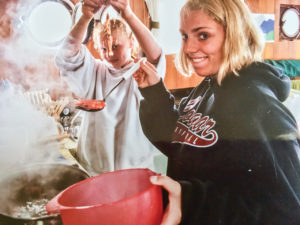
In line with their development, we turned boat-related activities into games such as “Silly Daddy Fell Overboard.” Dan threw a life ring into the water. One daughter kept her eye on the ring while the other popped the autopilot off the tiller and then turned the boat around. Boat hook at the ready, they took turns pulling “Daddy” from the water. They loved the game so much that they wanted to play it over and over, and learned how to do it like pros.
Extra line on board along with a book on nautical knots and macrame designs came in handy one year. The kids learned to tie bowlines and clove hitches and moved on to impressive macrame creations, some of which graced our boat for years.
Marathon family read-aloud books got us through the long passages. The Nancy Drew series (oldies but goodies), The Curve of Time, and I Heard the Owl Call my Name were a few favorites. The Harry Potter years (all seven of them) were particularly fun, the four of us gathered in the wheelhouse taking turns reading aloud while underway.
Of course, the sea itself provided diversion and entertainment. A kelp crab clinging to the line when we hauled anchor in Ford’s Cove on the backside of Hornby Island, became an unwitting babysitter. We plopped him into a bucket filled with salt water and he entertained the kids all afternoon. When we released him, we explained that he was not a pet, but a creature that needed to be at home in his natural habitat.
Our third boat, a 1932 Canadian ex-Forestry Service vessel, had a Dickinson cast iron stove and oven, excellent for baking bread (and cookies and cinnamon rolls) when we were far from a store. I loved watching our kids, up to their elbows in flour, kneading and shaping the dough, punching it down after each of its risings. And then those golden loaves emerged, filling the boat with a smell that, mixed with the saltwater breeze, is what heaven must smell like.
Rough Seas, Occasionally
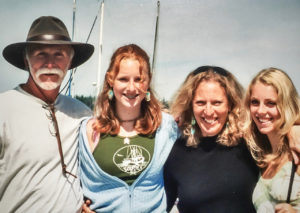
In case you are tempted to call me out for painting an impossibly blissful picture, let’s talk about the pre-teen and teen years. At times, the Zen soundtrack came to a screeching halt. There were summers when I wanted to hop on the nearest seaplane and fly home. Alone.
As one daughter describes it, “We had our best times on the boat trip, but also our worst fights.” One memorable afternoon, during a long stretch of stormy weather — rain gear hanging by the door and dripping onto the floor, cabin leaks picking up like waterfalls after a heavy rain, dog toys and lifejackets strewn about the floor — I was drinking some good, strong coffee to fend off seasickness when all hell broke loose during an altercation over a game of UNO. The fury in the boat matched that of the storm outside. I listened to a desperate reading of the rule in question, a vain attempt to make amends and finally, forced to step in, I ordered total separation. The 12-year-old to the V-berth to read, the 9-year-old to cool down in the aft cabin with me.
These times, too, had their lessons and upsides. Our daughters learned that no matter what, they were all each other had and they had to figure it out.

The teen years, when they were too young to be home alone, but too old to really want to spend an entire summer with only each other (and us) for company made for some miserable days. They were increasingly aware of what they were leaving behind: friends, television, city conveniences, and activities. To compensate and to ease into the trip, we allowed our elder daughter to bring a friend for at least the first week of the trip; and eventually did the same for our younger daughter. As much as they enjoyed having their friends on board, there seemed to be an inaudible sigh of relief when the friends left and we set about doing what we do as a family. It provided relief and reassurance when, eventually, even these antsy teenagers seemed to relax into the pressure-free environment. The sorts of things their age group dealt with — schoolwork, peer conflicts, judgment, and debilitating crushes — had no place on the boat.
Becoming Boat Kids
Our daughters learned to read tide tables, challenged by their father to let him know when we would have to leave our current location to make a particular set of rapids at slack tide. “Daaaaad,” they complained, “this feels like school.” But they did it, and soon became more adept than I at calculations.
The farther north we traveled, we found more opportunities to meet others like us — families cruising together for the sheer joy of being out there. When we spotted a boat full of kids, we always figured out a way to connect with them. A small rowing dinghy and, later, inflatable kayaks gave them “wheels” and the ability to be independent and free.
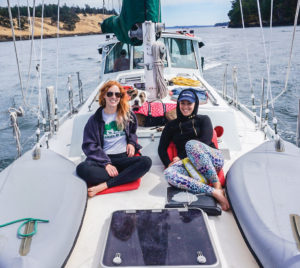
the summer cruise.
In the Broughtons one year, anchored in a one-boat cove on Insect Island (a name which belies its unspoiled beauty), a group of kayakers paddled by and invited us to a feast on the beach — the site of a former summer camp for the Musgamagw Dzawada’enuxw nation. We contributed cold drinks and fresh-baked bread, and they cooked up clams, crab, salmon, and pasta. We sat around their campfire until dark, savoring the company and reflecting on the fact that people were doing a version of this in this exact same spot 10,000 years ago.
One night, sitting in our pilothouse while the kids and their guests from two neighboring boats hung out in the salon, we overheard them talking about sail changes in the middle of the night; taking the Nakwakto rapids during its few minutes of slack; and wildlife stories, the stuff of legend. Dan & I looked at each other. “This is why we do this,” I whispered.
A calendar page that I displayed on the boat for many years read, “A Family Goes on Vacation to Become a Family Again.” Our grown daughters look back and marvel at the way they spent their summers. They no longer complain about having been cruelly parted from their friends and forced to spend summers on a boat with their dumb parents. They often thank us for the experience of living in concert with nature during long, languid summer trips. They reminisce about experiences we had together and that defined our family culture.
There are as many reasons to cruise and ways to keep children occupied on board as there are families. I don’t pretend to have more or better answers, but I will say this when reflecting on our journeys as a cruising family: Do it. Find a way. Get your kids out in nature and teach them how to entertain themselves, meet other boat kids, and appreciate a world that may be disappearing.
It brings to mind something a fellow boater (on a 24-foot San Juan with two young children aboard) once said: “Raising kids on a boat, even part-time, is challenging. But you get a better kid for it.”
Irene Panke Hopkins
Irene Panke Hopkins is an essayist who cruised and lived aboard her Discovery 42 sailboat for many years. She's now enjoying a new experience with land life in Port Townsend, Wash.



